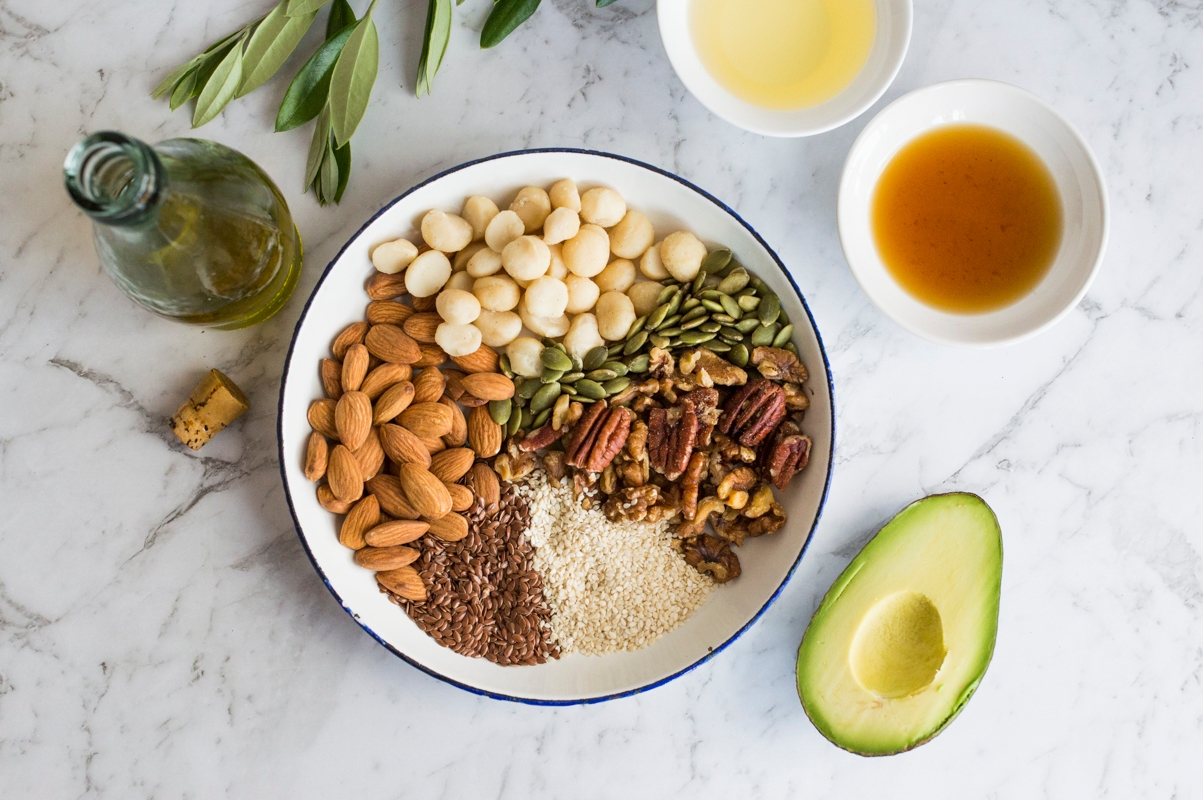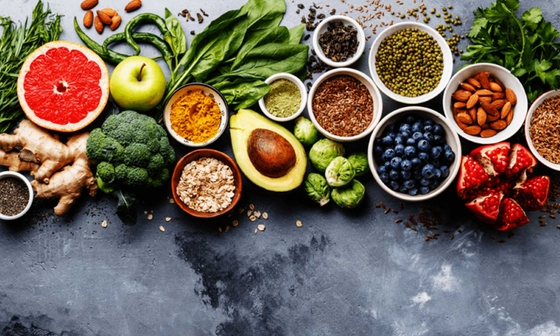
Fats, oils and heart health
Get the right balance of healthy fats in your diet
Key takeaways
5 min read
- The type of fat you eat plays an important role in your heart health.
- Choose healthy fat options, which include nuts, seeds, avocados, olives and their oils for cooking.
- Discover easy swaps and tips to increase your intake of healthy fats.
While eating fatty food may sound like a bad thing, some fats can play an essential role in keeping your heart healthy.
Many foods we eat contain different fats and some are healthier than others.
Choosing healthy fats can:
Aid healthier blood cholesterol levels.
Lower other cardiovascular (heart) risk factors.
Add flavour to food.
What are the different types of fats?
There are four main types of fats:
Monounsaturated fats
Polyunsaturated fats
Saturated fats
Trans fats.
Healthy fats
They include:
Monounsaturated fats
Polyunsaturated fats (omega-3 and omega-6).
Foods rich in healthy fats include:
Nuts and seeds and their butters/spreads
Olives and avocados and their oils/spreads
Oily fish like salmon, mackerel and sardines
Unhealthy fats
They include:
Saturated fat
Trans fat
Foods rich in unhealthy fats include:
Animal fats including butter, ghee and lard along with the visible fat/skin on meat
Hydrogenated plant oils like copha, vegetable shortening and some margarines
Coconut oil
Processed foods such as baked goods (cakes, biscuits and pastries), processed meat ( bacon, sausages, salami) and fried and takeaway foods.
Choose foods with healthy fats such as avocados, olives, nuts and seeds, and use healthy oils for cooking, for example, olive, canola, sunflower, peanut and soybean oil.
Reduce the amount of highly processed food you eat (such as baked goods including cakes, biscuits and pastries, along with processed meat, and fried and takeaway foods). These foods are high in saturated and trans fats, added sugar and salt, and are not part of a heart-healthy eating pattern. Try to have these foods only sometimes and in small amounts.
The relationship between heart disease and fats
Unsaturated fats
Unsaturated fats can help improve cholesterol levels by decreasing bad (LDL) cholesterol and increasing good (HDL) cholesterol. Low LDL cholesterol levels can help lower your risk of heart disease.
Omega-3 fats
Omega-3 fats are a type of polyunsaturated fat that can help:
Lower heart rate and improve heart rhythm.
Decrease the risk of clotting.
Lower triglycerides.
Reduce blood pressure.
Improve blood vessel function.
Delay the build-up of plaque (a fatty substance) in your arteries.
Unhealthy saturated and trans fats
Unhealthy saturated and trans fats can heighten your risk of heart disease by increasing the bad (LDL) cholesterol. Of all fats, trans fat is the worst for health and is associated with an increased risk, incidence and mortality from heart disease.
How much fat should you eat a day?
It’s the big picture that matters. The type of fat you eat is more important than the total amount.
You can get the balance of fats right by:
Choosing more foods with healthy fats, and less foods with unhealthy fats (see our tips below)
When cooking and preparing foods, choose olive oil (along with sunflower, peanut and sesame oils) over animal fats.
Include more meals which use legumes (including beans and lentils) and oily fish instead of meals with red meat and/or processed meat.
Choose foods from our heart healthy eating pattern to help make healthy choices, and get the right balance of fats.
Eat more healthy fats
Foods that contain healthy monounsaturated fats include:
Avocados
Unsalted nuts such as almonds, cashews and peanuts
Olives
Cooking oils made from plants or seeds, including: olive, canola, peanut, sunflower, soybean, sesame and safflower.
Foods that contain healthy polyunsaturated fats (omega-3 and omega-6) include:
Fish
Tahini (sesame seed spread)
Linseed (flaxseed) and chia seeds
Soybean, sunflower, safflower, canola oil and margarine spreads made from these oils
Pine nuts, walnuts and brazil nuts.
Try to eat omega-3 from all three sources
1. Marine
Oily fish, such as tuna, salmon, and sardines
Barramundi
Flathead
Scallops
Mussels.
2. Plant
Walnuts
Linseeds (flaxseeds)
Chia seeds
Oils and spreads.
3. Animal
Eggs
Chicken
Beef.
Help lower your cholesterol with plant sterols
To lower LDL-cholesterol the Heart Foundation recommends adults consume 2 to 3 grams of plant sterols per day from plant sterol enriched foods. Plant sterols are cholesterol-like substances that can lower cholesterol levels. They are found naturally in foods such as fruits, vegetables, nuts and cereals but only in small amounts.
To help meet the 2 to 3 grams of plant sterols per day, look for foods which have plant sterols added, such as:
Margarine
Milk
Yoghurt
Breakfast cereal
Eat less unhealthy fat-containing foods
Saturated fats
Saturated fats can be found in both animal and plant products. When eating less saturated fat, the foods you replace it with are important. Follow the Heart Foundation’s heart healthy eating pattern to achieve a healthy mix of fats.
Foods that commonly contain saturated fats include:
Butter
Coconut oil
Palm oil (often called vegetable oil in products)
Processed foods, such as biscuits, cakes, pastries, pies, and takeaway foods
Lard
Ghee
Copha
Dripping
Fat on meat
The skin on chicken and other poultry
Processed or deli-style meats, such as salami, ham, and bacon
Cream
Ice cream.
Trans fats
Trans fats are found naturally in some foods, such as butter, dairy and some meat products. Most of the trans fats eaten in Australia are from processed foods.
Some trans fat-containing foods to eat less of include:
Deep-fried foods
Biscuits, cakes and pastries
Butter
Takeaway foods, such as hamburgers, pizza and hot chips
Foods that list ‘hydrogenated oils’ or ‘partially hydrogenated vegetable oils’ on the ingredients list.
Increase healthy fats in your diet
Making healthier food choices can be difficult. The table below provides some healthy alternatives for a snack or meal.
| Swap this | For this |
|---|---|
| Muffins, chips or biscuits | Fruit, nuts or veggie sticks |
| Deep-fried foods | Steamed, boiled or pan-fried foods |
| Butter or coconut oil in cooking | Olive, canola, peanut or sunflower oils |
| Butter as a spread | Avocado, nut butters, tahini or margarine made from healthy oils |
| Sausages and other processed deli meats | Healthy protein sources (fish, legumes, chicken, lean red meat) |
You might also be interested in...

How to follow a heart healthy eating pattern
Follow these easy tips to boost your heart health and embrace a heart-healthy eating pattern.

Fruit, vegetables and heart health
How to boost your fruit and vegetable intake to help protect your heart.

Dairy and your heart health
Not all dairy products are equal. Discover different types of dairy foods and their impact on heart health.
Last updated19 March 2024